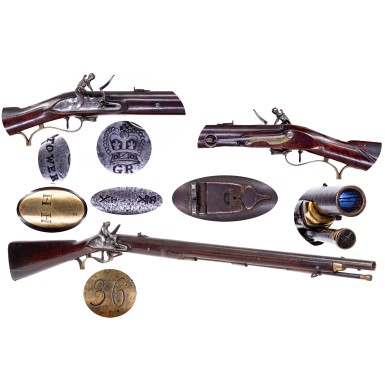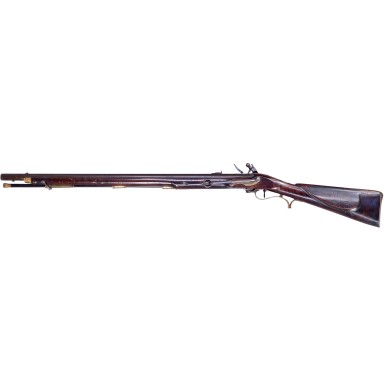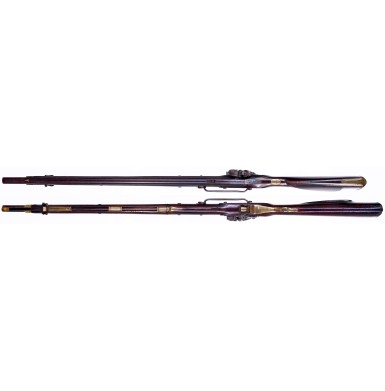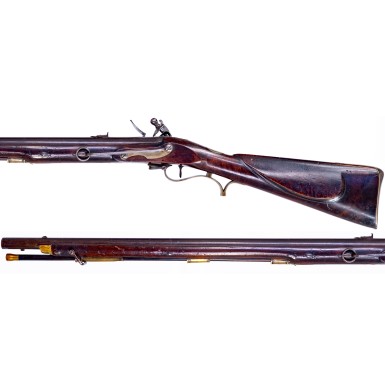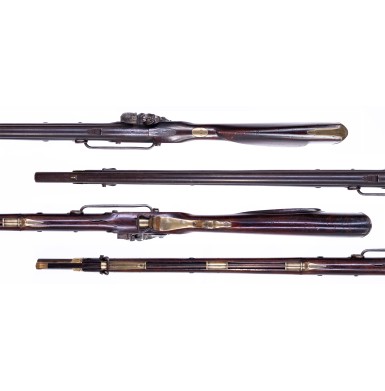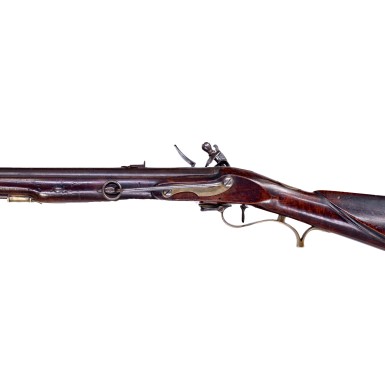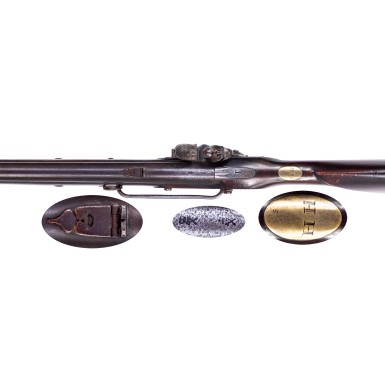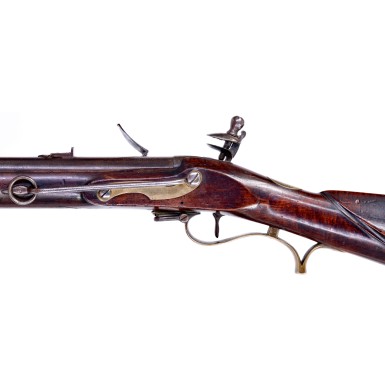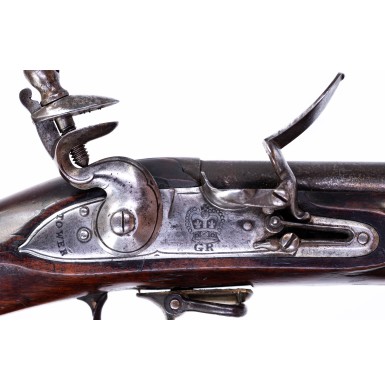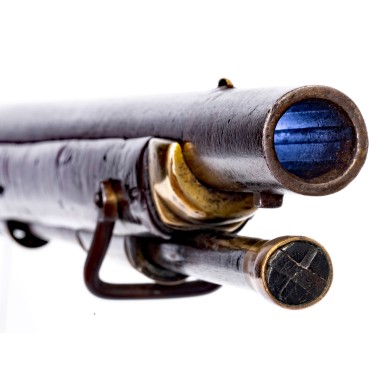Extremely Rare HH Unit Marked Baker Cavalry Rifle - Likely for the Hompesch Hussars
- Product Code: FLA-4082
- Availability: Out Of Stock
-
$0.00
The patterns of carbines used in British mounted service during the 18th and much of the 19th century are a tangle of types, variations, sub-types and show an overall lack of standardization that would not be resolved in British service until the third quarter of the 19th century. Some of this was due to the fact that from the mid-18th to mid-19th century there was a substantial evolution in the way in which cavalry was used by the British and also due to the fact that standing cavalry regiments were not maintained at the same level as the infantry and so an emergency mobilization of large numbers of mounted men often left the Board of Ordnance ill prepared to equip the sudden increase. While the development and eventual specialization of British cavalry is well beyond the scope of the purpose of this description, it is worth noting some broad generalizations about the purposes of cavalry and way in which the British military sought to arm them.
As noted, many fewer regular cavalry regiments were maintained by the British than were infantry regiments, with the theory that in times of national crisis more could be raised and fielded and that the yeomanry (militia) cavalry regiments could help to fill the needs of the Empire as well. As such, the supplies available to equip these new units were not as readily available as the large stores of infantry arms and equipment maintained at the Tower of London. During the third quarter of the 18th century there were a wide variety of mounted regimental types, which had developed from the two original categories of the pre-1746 period, “Horse” and “Dragoons”. As described by authors Chisnall & Davies in their book British Cavalry Carbines & Pistols of the Napoleonic Era, the term “Horse” referred to “a superior breed of cavalry and ‘Dragoons’…who functioned as mounted infantry.” The “Horse” were for all practical purposes the relic remnants of the heavy cavalry that had been relied upon to break enemy lines and were the shock troops of the army since the days of mounted knights. By the 3rd quarter of the 18th century mounted troops in Great Britain and on the Continent were becoming far more specialized and were being further classified as both Heavy and Light Dragoons, Heavy and Light Cavalry, and even took on more specific roles like Hussars and Lancers. Dragoons continued, at least in theory, to operate as mounted infantry, providing a level of speed and mobility that infantry did not possess in a time before railroads and eventually other modes of motorized transportation. Cavalry took on more specialized roles such as scouting, screening the movements of an army, pursuing broken enemy formations and protecting lines of communication and supply. As the British mounted forces had long included many “Dragoon” regiments, the concept of a providing a short, handy, long arm for use on horseback was largely ignored. These men were to dismount and serve as infantry, so an infantry style long arm was most appropriate. To that end, many in the British mounted services were armed with 42” barreled “Short Land Pattern” muskets or an equally long, but slightly lighter and smaller caliber Heavy Dragoon & Life Guard Carbine. In the third quarter of the 18th century a number of new, but hardly standardized, patterns of calvary carbine began to be issued to the troops, but the fact that many of them were still designed to accept a bayonet showed that the long arm was not considered a mounted weapon per se, but rather one that was used dismounted when fighting like infantry. In general, these arms were smoothbore and either musket bore (nominally .75 caliber) or carbine bore (nominally .65 caliber). The use of rifled arms by the cavalry was not completely unheard of, as they had been used in very small quantities as early as 1680 when “by His Majesty’s Command, eight rifle carbines were carried in each troop of the Life Guards,” but it was most certainly the exception and not the rule. A small number of British Pattern 1776 Rifles also saw service in America with the 16th and 17th Light Dragoons during the American Revolution.
The beginning of more than three decades of nearly continuous war with France that would start with that country’s support of the Americans during the American Revolution (1775-1783), continue during the French Revolutionary Wars (1793-1802) and would eventually expand to a near world war level conflict that are known collectively as the Napoleonic Wars (1803-1815). This period would see the British military expanded to a previously unimaginable size and the varieties of long arms issued to the mounted troops expand as well. During this period numerous experimental arms were adopted by various regimental colonels who had very specific ideas about what the best weapon was, and many of the militia regiments pressed into service came equipped as their colonel had seen fit, meaning that previous lack of standardization in cavalry long arm patterns was only exacerbated. Additionally, the adoption of Ezekiel Baker’s Rifle in 1800 for issue to riflemen in the army, most notably the 5th Battalion of the 60th Regiment of Foot and the 95th Rifles, brought the capabilities of rifled long arms back to the forefront of military thought. The effective use of rifled arms by the Americans during the Revolutionary War had taught the British as lesson that they had not forgotten. With the adoption of the Baker Rifle for infantry use and with experimental rifled carbines in the field with some regiments like The Duke of Richmond’s Egg Spear Carbine, rifled arms started seeing some more use among in the mounted services. As early as 1801 some infantry Baker Rifles were delivered to the Life Guards and in 1803, trials were held with rifled carbines designed by both Baker and his former mentor Henry Nock. In the end the Baker design won out. Designated by collectors as the Pattern 1803 Baker Cavalry Carbine, it was essentially a 20” barreled version of the 36” barreled flintlock Baker Infantry Rifle adapted for mounted service. It retained Baker’s 7-groove rifling and .65 caliber bore, along with the general silhouette of the infantry rifle, including the skeletonized pistol gripped brass triggerguard. It also retained the brass patchbox, fixed block rear sight and brass blade front sight. The most important features that made it useful for mounted service other than the overall shortening of the gun were the addition of a sling bar and ring on the reverse, and the inclusion of a captive steel swivel ramrod. The carbine showed enough promise that the first 160 guns were issued in July of 1803 to the 14th and 15th Light Dragoons, each receiving 80 of them. By the end of the Napoleonic Wars, some 3,000+ Baker Rifled Carbines had been set up and issued to the 7th, 8th, 9th, 10th, 11th, 13th, 14th, 15th, 18th, 21st and 23rd regiments of Light Dragoons, of either the original 1803 pattern or the later wooden pistol gripped 1813 pattern.
But the 20” standard issue Baker Rifled Carbine was not the only version of the design to service during the Napoleonic Era. A number of “Volunteer”, non-Ordnance Pattern, variations saw service as well. One of the most intriguing was for all practical purposes a cavalry adapted version of the Pattern 1805 Baker Infantry Rifle. While the standard Infantry Rifle was stocked nearly to the muzzle and had a bayonet bar on the left of the barrel that accepted a brass handled saber bayonet, these guns are stocked to within 3” of the muzzle and had a socket bayonet stud under the barrel, 1.5” from the muzzle. It was worth noting that this modification was adopted and applied to about 2,000 of the Infantry Rifles in 1815, eliminating the bayonet bar. The guns are equipped with a 6” sling bar on the reverse of the stock, clearly indicating their intended use with mounted troops, although they also retained their sling swivels as well. The guns were commercial guns and were built with higher grade TOWER marked locks that incorporated roller frizzens, included a more complicated backsight than Ordnance pattern guns.
All surviving examples are inevitably unit marked HH on the wrist escutcheon and then rack numbered on the triggerguard. An example rack numbered 33 is pictured and discussed on page 173 of British Cavalry Carbines & Pistols of the Napoleonic Era by Barry Chisnall and Geoffrey Davies. It is also shown in their book British Commercial Military Carbines on page 64 and the book Non-Ordnance Carbines on page 53. The meaning of the “HH” regimental marking has been debated with some suggesting it means “Henham House” and others, most notably the late Howard Blackmore, suggesting it is the mark of the “Hompesch Hussars”. To date six examples are known, including this one. They are numbers 13, 33, 36, 37, 39 and 40. One example has a 17” barrel, the balance are of the rifle configuration described above. An argument that these “Volunteer” carbines were set up for the Earl of Stradbroke who maintained a Yeomanry militia cavalry force at Henham Hall in the county of Suffolk, near Blythburg falls flat upon examination of both the guns and the economic resources of the various Earls who held the title and poor agricultural community that Henham Hall was set in. The period of the guns would coincide with the 1st Earl of Stradbroke, John Rous’ last decade or so of life, a time when he was actively pursuing his interest in racehorses and would seem unlikely to be expending a large amount of money on advanced arms for militia cavalry who would have little to do other than try to maintain order among the peasants who worked his land. The connection to Baron Hompesch’s Hussars has been rejected out of hand by some due to the fact that the original Hussar compliment was largely decimated by disease while serving in the West Indies during 1796-1797, and by the end of 1797 the unit essentially disappears from service, for all practical purposes pre-dating these circa 1800-1815 rifles.
However, further research indicates that the Hompesch brothers Charles and Ferdinand raised a number of different and interrelated companies and squadrons that saw British service during the late 18th and early 19th century. Baron Charles de Hompesch-Bolheim of Prussia and his brother Ferdinand agreed on 27 February 1794 to raise two companies of Chasseurs à Pied and three squadrons of Hussars for British service during the French Revolutionary Wars. The Chasseurs à Pied fought splendidly as part of the Duke of York’s Army at Boxtel on 14-15 September 1794, where they engaged in a nearly suicidal delaying action after a retreat by Hessian allies allowed a French cavalry penetration of the English lines. Between this major fight and other engagements that year the companies were disbanded in early 1795 with some joining Hompesch’s Hussar contingent. Hompesch’s Hussars did not perform as well as the Chasseurs à Pied had at Boxtel and did not distinguish themselves during the balance of the 1794 campaign. They were subsequently ordered to service in the West Indies, which freed other British troops to serve on the continent. Interestingly, despite their lack of distinction in January of 1796 the Hussars were being identified as the “Prince of Wales’s Hussars.” During the Hussar’s service in Santa Domingo from July of 1796 to July of 1797 they lost more than two-thirds of their strength due to disease. At that point the Hussars essentially ceased to exist as an independent fighting force, but the York Hussars received a draft of men from the survivors to bolster their numbers. The remaining officers returned to England in November of 1797.
Another associated Hompesch force of Fusiliers was raised by Ferdinand Hompesch beginning in March of 1796. In addition, a supporting Hompesch force of some 200 mounted men was proposed to be raised and was accepted. It is worth noting that in C.T. Atkinson’s Foreign Regiments in the British Army 1793-1802 he notes of this Hompesch force that, “In the original contact the whole corps was to be armed with carbines ‘like the Prussian Schutzen’ and ten men per company were to carry rifled carbines of a special pattern. This must have been an experimental weapon, as of the £24 per head levy money only £15 was to be paid down, the rest being held back till the arms had been on trial for six months and had proved satisfactory.” It is further noted that the force not only included the mounted support but also two companies of riflemen. This force of fusiliers, minus their mounted contingent was also sent to the West Indies where it served on Martinique, Trinidad and Antigua. Again, disease devastated the Hompesch men and on 1 May 1798; after suffering nearly 50% casualties, the remaining men were absorbed into the 2nd Battalion of the 60thRegiment of Foot. A few of the officers and men were subsequently transferred to the newly forming rifle battalion of the 60th, the 5th. The supporting force of horsemen that had been raised to support the Fusiliers had apparently remained in limbo during the Fusiliers West Indies service and were reorganized into a separate corps of Mounted Riflemen in January 1798 and in April were sent to Ireland in support of the 60th Regiment of Foot’s 5th Battalion to suppress the Irish Rebellion that year. As Hompesch men were part of the 60th’s 5th Battalion, it was likely somewhat like a reunion. In July of 1800 the remaining portion of the Hompesch Mounted Rifle force of 7 officers and 157 enlisted men were sent as part of General Pulteney’s force to Spain where they were part of the Ferrol Expedition, fought at Cadiz and then proceeded to Egypt as part of Abercromby’s Egyptian expeditionary force, serving in General Finch’s cavalry brigade. By the end of the campaign the Hompesch men numbered only 138. In mid-1802 the remaining men were returned to garrison duty in Ireland and at the end of September their service was ended. Most returned to their home countries, although some did reenlist and subsequently served in the 20th Light Dragoons.
This rather detailed history certainly makes it apparent that the “HH” marking could well be related to Hompesch’s men, and it is known that the mounted force that supported Ferdinand’s Fusiliers was known by a variety of names including mounted Chasseurs, Fusiliers and Light Infantry. As some of the officers who commanded the group, as well as at least a few of the men were original Hompesch Hussars, they almost certainly thought of themselves in that way. The reference to a small number of the men being issued special and expensive “rifled carbines” further supports the theory that these guns are related to this regiment and since they were procured in the fairly small quantities of “10 men per company”, it seems reasonable that no more than about 50 or 60 were acquired, squaring quite nicely with the highest extant inventory number on these guns known being 40. The recruitment of some 200-250 men to serve as mounted support to the fusiliers would suggest 2 to 3 squadrons of cavalry, typically comprised of 2 companies each, which would mean that 4 to 6 companies were raised. Based upon the suggested ration, that means that 40 to 60 of the special rifled arms would have been acquired. The special and “expensive” features of the arm, beyond the fact that they were Baker rifles, were the more sophisticated lock with roller frizzen, more complicated rear sight, the special forend for socket bayonet mounting and the inclusion of the cavalry sling bar in addition to the sing swivels. It is worth noting that the lock plates themselves appears to be an Ordnance supplied locks, as they marked TOWER and have the engraved GR under the crown, something that purely commercial guns with no intended government, versus militia, military service would have.
Offered here is a FINE condition example of one of these rare HH Unit Marked Baker Cavalry Rifles. As noted, only six are known, and this is number 36. To my knowledge, this is the only one in the United States. The configuration of this gun is the same as all other known examples I have been able to find data on, with the exception of the single 17” barreled gun which may be an anomaly due to post-service shortening. The rifle has a browned 30.5” round barrel with a break off breach that is secured to the walnut stock with three keys and the upper swivel screw. The top of the breech is stamped with two {CROWN/CROSSED SCEPTER} “Tower Private Proof” marks. The stock extends to within 3” of the muzzle and a lug to secure a socket bayonet is located 1.5” from the muzzle, under the barrel. It is nominally ¼” long and about 13/64” wide. The overall length of the gun is 46.25” with a 14” length of pull. The rounded flint lock is 5 ¼” in length with a pronounced teat at the tail and has a single line of engraving around much of the periphery. The lock is marked TOWER in a vertical arc at the tail and with an English {CROWN}/GRcypher under the pan. The file slash mating mark | | is found on the lower edge of the lock plate and inside the lock cavity of the stock. The integral rounded iron pan is semi-waterproof, fenced and bridled. The frizzen toe is curled and the lock employs a roller frizzen. The cock is of the rounded swan neck form with an engraved line around its edge and has a notched comb. A flat New Land style side plate is mounted on the counterpane with two lock screws and a 6” sling bar is attached to the reverse of the stock. The rear lock mounting screw secures the rear of the sling bar and a smaller screw that enters from the obverse of the stock secures the front of it. The brass triggerguard is of the typical Baker style skeletonized pistol gripped form and is 7 ¼” in overall length. The sling swivels are of the typical infantry rifle pattern, with the lower one mounted on the face of the triggerguard bow and the upper one mounted 2 ¼” from the stock tip. The brass stock tip is 7/8” long and stepped, like those found on the 1815 modified Infantry Rifles. Three pinned brass thimbles retain the ramrod, the first is nominally 3 ½” long and 5 ¼” from the muzzle, the middle pipe is nominally 1 11/16” and is 10 ¾” from the muzzle and the entry pipe is nominally 3 1/8” including the tail. Unlike the Infantry Rifle and Ordnance Pattern Baker Carbines, this one does not incorporate a patchbox. However, the stock does have a raised cheek rest. The leaf rear sight is of a different and more complex pattern than Ordnance sights of the period. It is dovetailed into position 3 ½” from the breech. It includes a fixed notch that is likely regulated for 50 or 100-yards and a folding leaf that has a wide aperture for something around 200 yards, a tiny hole aperture that is probably for 300 yards and then a curved V-shaped notch at the top that is probably for 400 or 500 yards. The front sight is a dovetailed brass blade that is set slightly less than 3” from the muzzle. There is a brass tipped wooden ramrod present that appears to be a high-quality modern replacement, as it would be most appropriate for these rifles to have been issued with a thick, button head steel ramrod. A brass thumb piece escutcheon is present in the wrist of the stock and is engraved HH and the bow of the triggerguard is engraved 36.
As noted, the gun remains in FINE condition and with the exception of the ramrod and possibly the stock tip appears to be 100% complete, correct and original in every way. The lock remains in original flint and is unmolested, and the barrel remains in original flint as well and endoscopic examination reveals not welding, repairs or modifications in the breech area. The touchhole shows some moderate erosion but nothing out of the ordinary and is well placed and centered in the pan. The lock has a silvery gray patina and shows some oxidized freckling and discoloration. The lock is mechanically functional and remains quite crisp. There is a small crack at the rear of the body of the swan neck of the cock, so it should be handled carefully and probably not used to fire the gun. The barrel retains some traces of browned finish mixed with an attractive and uncleaned moderately oxidized brown patina. The metal is mostly smooth but does show some scattered surface roughness and patches of light pitting. The bore of the rifle is VERY GOOD and retains deep seven groove rifling with moderate amounts of oxidation and some scattered pitting. The brass furniture has a medium golden patina. The pin that secures the triggerguard post is missing, so the front of the triggerguard is not fully seated against the belly of the stock. The stock tip is a little loose and as mentioned is of the stepped type found on the 1815 altered Infantry Rifles. The images that I have found of HH Marked Baker Cavalry Rifles #33 and #39 show an unstopped stock tip that is more in the style of that of an Infantry Musket, but somewhat more rounded. As such, this stock tip may be a replacement. The ramrod is also almost certainly a replacement, as these would certainly have had steel ramrods. The stock remains in FINE condition as well and is unmolested, showing no signs of sanding or abuse. The stock is full-length, crisp and free of any breaks or major repairs. There is an area of wood loss in the belly, forward of the triggerguard where the ramrod channel was cut too close to the exterior of the wood and has worn through. This can be found in many martial arms of the period, including US muskets. A small piece of wood, nominally 1 ¼” long and ¼” wide chipped out and was glued back in place at some point in time and an area nominally 1 1/16” long and 1/8” wide is missing the wood completely due to the wear. There is also a small crack and tiny chip missing at the barrel juncture along the reverse of the forend. Otherwise, the stock remains fairly crisp as noted with good lines and edges and showing the typical scattered bumps, dings and mars from service, use and age, along with some discolored marks on the wood and a couple of tiny chips in the lock mortise area.
Overall, this is really great example of a scarce Napoleonic Wars era unit marked Baker Cavalry Rifle. The gun is in lovely condition, essentially complete and correct with the exception of the ramrod and possibly the stock tip and remains in original flint. The gun is well marked and one of only six known examples so marked and five so configured. While it is impossible to know for sure to whom these guns are marked, noted English arms historian Howard Blackmore felt it was likely Hompesch’s Hussars and my substantial research suggests he is probably correct. As noted, I have not found any indication that the other surviving examples are anywhere except Great Britain, so this is likely the only example in America that a collector will have access to. This is a really great rifled carbine that I am sure you will be very proud to add to your advanced collection of British marital and Napoleonic arms.
ON HOLD/LAYAWAY
Tags: Extremely, Rare, HH, Unit, Marked, Baker, Cavalry, Rifle, Likely, for, the, Hompesch, Hussars

